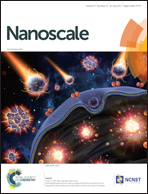Bioinspired peptosomes with programmed stimuli-responses for sequential drug release and high-performance anticancer therapy†
Abstract
Combination therapy with enhanced therapeutic and antimetastatic efficacy has become promising for cancer treatment. There is an urgent need to design a co-delivery system to sequentially release the drug pair at desired locations that can increase the intra-tumoral drug concentration and reduce the side effects. Inspired by virus architecture and function, herein, we developed a peptosome (PS)-based co-delivery system, PePm/PS/Curcumin (Cur), for the sequential release of the therapeutic peptide Pe and chemodrug Cur. PS was formed by the self-assembly of amphiphilic α-lactalbumin peptides obtained from enzymatic partial hydrolysis. Then, PS was self-cross-linked with disulfide bonds utilizing their endogenous thiol groups. The system is responsive to multiple tumor microenvironments and releases the drugs at specific tumor locations. First, after PS accumulation in tumor tissue via the EPR effect, the linkage peptide Pm in PS can be cleaved by matrix metalloproteinases (MMP) enzymatic hydrolysis. Pe can stay on the cell surface and antagonize the ErbB-2 receptor expression on the tumor cells. Moreover, the positively charged nature of remaining Mal-PS/Cur facilitates tumor cell internalization and induces a subsequent proton-sponge effect for lysosomal escape. Finally, Cur is released in the cytoplasm via a reduction-induced PS disassembly due to the high level of intracellular GSH. Both the in vitro and in vivo results exhibited an enhanced antitumor and antimetastatic efficacy of this system.



 Please wait while we load your content...
Please wait while we load your content...